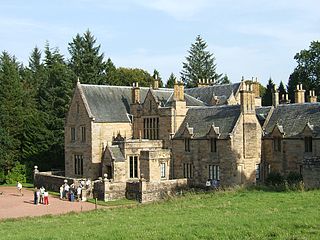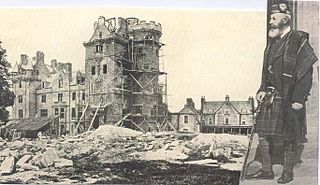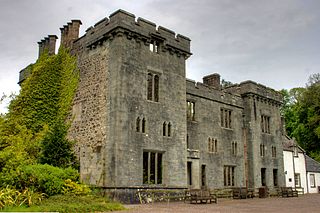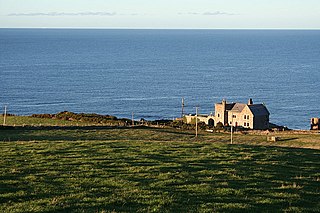
Kilravock Castle is located near the village of Croy, between Inverness and Nairn, in the council area of Highland, Scotland. It was begun around 1460 and has been the seat of the Clan Rose since that time. The castle is a composite of a 15th-century tower house and several later additions. The original name for the castle was Cill Rathaig; Scottish Gaelic meaning "church at the small circular fort".

Corehouse is a country house and estate, located 2 kilometres (1.2 mi) to the south of Lanark, Scotland. The estate is by the Corra Linn Falls on the River Clyde, and close to the World Heritage Site of New Lanark. The house was designed by Sir Edward Blore for George Cranstoun, Lord Corehouse, and was completed in 1827.

Beaufort Castle or Castle Dounie is a Baronial style mansion built in 1880 and incorporating older building work. It is situated on the right bank of the River Beauly near the town of Beauly in Inverness-shire and is 1 mile (1.6 km) north of Kiltarlity and 13 mi (21 km) west of Inverness. There has been a castle on the site since the 12th century. Beaufort is the traditional seat of the Lords Lovat.

Armadale Castle is a ruined country house in Armadale, Skye, former home of the MacDonalds. A mansion house was first built here around 1790, facing south-east over the Sound of Sleat. In 1815 a square Tudor-Gothic mock-castle, intended for show rather than defence, designed by Edinburgh architect James Gillespie Graham, was built next to the house.

Castle Leod is the seat of the Clan Mackenzie. It is a category A listed building, and the grounds are listed in the Inventory of Gardens and Designed Landscapes of Scotland, the national listing of significant gardens. It is located near Strathpeffer in the east of Ross-shire in the Scottish Highlands.

Balfour Castle is a historic building on the southwest of Shapinsay, Orkney Islands. Though built around an older structure that dates at least from the 18th century, the present castle was built in 1847, commissioned by Colonel David Balfour, and designed by Edinburgh architect David Bryce. It is a Category A listed building and the landscape and formal gardens are listed in the Inventory of Gardens and Designed Landscapes in Scotland.

Brahan Castle was situated 3.5 miles (5.6 km) south-west of Dingwall, in Easter Ross, Highland Scotland. The castle belonged to the Earls of Seaforth, chiefs of the Clan Mackenzie, who dominated the area.

Dundarg Castle is a ruined castle about 2 kilometres (1.2 mi) north-northeast of New Aberdour, Aberdeenshire, Scotland, built within the ramparts of an earlier Iron Age promontory fort. It was described by W. Douglas Simpson as one of the nine castles of the Knuckle, referring to the rocky headland of North-East Aberdeenshire, and by Charles McKean as "Scotland's answer to Tintagel". It became a small Celtic monastery for a period.
Brucklay Castle, also known as Brucklay House, is a 16th-century castle in the Buchan area of Aberdeenshire, Scotland.

Closeburn is a village and civil parish in Dumfries and Galloway, Scotland. The village is on the A76 road 2+1⁄2 miles (4 km) south of Thornhill. In the 2001 census, Closeburn had a population of 1,119. Closeburn is recorded as Killosbern in 1185. The first element of the name is Gaelic cill 'cell or church'. The second element is a saint's name, but none has definitely been identified.

Saltoun Hall is an historic house standing in extensive lands off the B6355, Pencaitland to East Saltoun road, about 1.5 miles from each village, in East Lothian, Scotland. The house is reached by way of an impressive gateway and is situated at grid reference NT461685.

Redcastle, historically known as Edirdovar and Ederdour, is a medieval castle in Killearnan on the Black Isle, northern Scotland. It is so named from the colour of the stone of which it is built. The castle is now in a state of ruinous disrepair, although it is protected as a category B listed building.

Cortachy Castle is a castellated mansion House at Cortachy, Angus, Scotland, some four miles north of Kirriemuir. The present building dates from the 15th century, preceded by an earlier structure that was owned by the Earls of Strathearn. It was acquired by the Ogilvies in 1473 and substantively modified in the 17th and 19th centuries. The 1696 remodelling was by Tobias Bauchop of Alloa.

Banff Castle is a ruined former royal castle near Banff, Aberdeenshire, Scotland.

Terpersie Castle is a 16th-century tower house in Tullynessle, Aberdeenshire, Scotland, located 5 kilometres (3.1 mi) north-west of Alford. It is protected as a category A listed building.

Midmar Castle is a 16th-century castle in Aberdeenshire, Scotland, located 12 kilometres (7.5 mi) west of Westhill and 3.5 kilometres (2.2 mi) west of Echt. The castle was built for George Gordon of Midmar and Abergeldie between 1565 and 1575, and was constructed by the stonemason and architect George Bell. The castle is protected as a category A listed building.

Hatton Castle is almost three miles (4.8 km) south-east of Turriff, Aberdeenshire in the north-east of Scotland. Formerly known as Balquholly Castle, sometimes spelt as Balquollie, it was renamed in 1814. The 17,994 square feet (1,671.7 m2) mansion was designated a category A listed building in 1972; the gardens are included in the Inventory of Gardens and Designed Landscapes in Scotland.

Dalcross Castle is a restored 17th century tower house, about 1+1⁄2 miles southwest of Croy, Highland, Scotland, and about 7 miles northeast of Inverness. The castle stands on a ridge.

Midmar is a historic settlement in Aberdeenshire, lying north of Banchory and southwest of Inverurie. It is noted for its three stone circles and various standing stones. Midmar and Sunhoney are both recumbent stone circles.



















